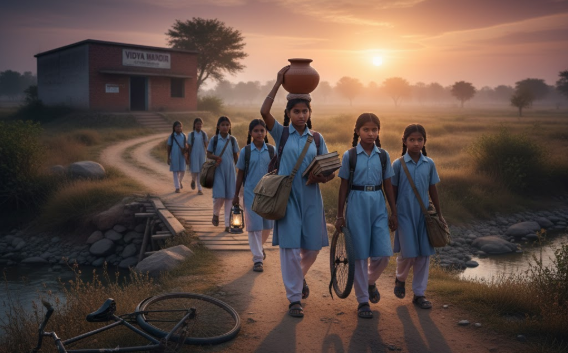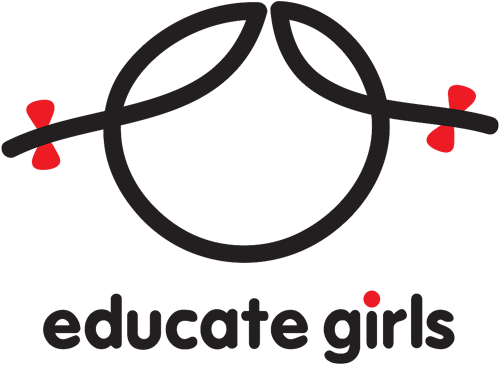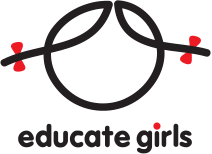Educating a young girl is one of the best investments her family, community, and country can make as it will lead a way to prosperity. It is the best way to reduce inequalities and develop a nation. Globally, there are 130 million girls who are not enrolled in school, and investing in their future holds the potential of uplifting the status of their families along with the nation. A good-quality education will increase their potential and help them identify a path to their success. Educated girls are most likely to marry later, have healthier children, earn more money and invest, live a nutritious life, play a leading role in their communities, and many more.
However, the challenges for girls’ education are complex and multifaceted. Over the last 2 decades, progress and upliftments were made in the matter but still there lies a long way to go. Apart from unfavorable school environments, there are discriminatory social and cultural factors, early marriage, patriarchal beliefs, gender-based violence, and a lot more that add to the list of underlying problems in girls’ education.
To protect future generations from the barriers of today, we need to understand the factors involved in restricting girls’ education in an in-depth manner.
1. Less Donation for Girls’ Education
A report shows that due to poverty, the cost involved in educating girls is one of the deciding factors of whether a girl can access education or not. Moreover, it is abundantly clear that the people living in rural areas are more consistent predictors of who stays in school or who drops out based on gender division. It is their economical condition that urges them to do so. Due to this, free-of-cost schools were started in many parts of the world to help educate the willing females. But this never seemed to be the one-stop solution as there were families in different areas of the globe who could not keep up with the costs of transportation, textbooks, or uniforms.
In low economic situations, parents are forced to send their young girls to work as laborers or slaves and they depend on their income for the household. All such conditions pressurize them to send their son to school. This highlights that there is totally a lack of donations for girls’ education. If more and more people could come up and donate a little proportion of their earnings towards the learning of young underserved girls then the world can grow and succeed together, leaving no one behind!
2. Patriarchal Beliefs
There exist cultures in which girls’ education is prohibited for many pre-believed reasons. While boys are allowed to attend school, girls’ opportunities are restricted and reduced considerably to the role of giving birth, raising kids, and undertaking household work. People in many parts of Africa, Kenya, India, etc. are stuck within these cultural beliefs due to their existing patriarchal traditions. It is not common for families to invest in their daughters before their sons. These kinds of beliefs pull society backward and limit the growth of a nation.

There must be enough advocacy among the people of underserved areas that they can help each other in limiting the dominant practices and allow for some degree of change in girls’ education. This attitude of elders preferring their sons over innocent daughters flourishes way beyond education and creates a fuss that is much more difficult to clear later. There lies a need of advocating for people and pushing them toward a wave of change.
3. Menstruation
Every month a lot of young girls step on a new stage of adolescence – Menstruation. What people believe in the underserved areas is that she will most likely skip school or work for a significant portion of her life just because she is on her period. And even if this is not the case, then families prefer to marry their daughters as soon as they begin to menstruate. This is because they feel that they have reached the age where they are capable enough to have kids and build up a family.
Poor financial conditions force people to think this way. Menstruation is stigmatized around the world and the cultural shame attached to this natural process embarrasses young girls and limits them from participating actively in society. In Nepal, menstruating girls are seen as impure and banished to the huts by society, this even leads to the death of many females.
Apart from this, the major problem is that many-a-times they cannot afford to purchase sanitary products or they don’t have access to hygienic toilets and proper sanitation at schools. All these things push them a little harder to quit their education and follow the “destined” ending.
4. Gender-Based Violence
All over the globe girls are at a higher risk of violence and sexual abuse in society. Gender-Based violence can take up many forms like physical and sexual abuse, harassment, and bullying. Surviving rape, discrimination, or any other type of abuse can affect girls’ enrollment, reduce their participation and achievements, and can even trigger dropout rates. Long distances to school are often problematic as they have to take up public transport which is not safe in many parts of the world.
Traveling such long distances every day can be dangerous as reports suggest that many young girls become victims of rape or harassment on their way back home. In countries affected by conflicts, girls feel danger and terror and resist going to school alone. Tanzania reported that almost 1 in 4 girls who experienced sexual violence, met such an accident while traveling to or from school. Such incidents generate a feeling of terror and parents are most likely to withdraw their daughters’ enrollment in case of long distance. So, gender-based violence must be eliminated from the society as it can support ladies to step forward, study, and take a stand for themselves.
5. Trafficking
Human trafficking is a depressing, terrifying yet the most common thing and the number of girls reported as a victim of this is on the rise. In 2016, out of all the trafficking victims reported, 83% were young girls and the rest were males, adults, etc. Many-a-times traffickers exploit girls for forced labor or child marriage, but most commonly they are pushed into sexual exploitation. Trafficked women and girls have to face high degrees of physical and sexual violence along with unwanted physical and mental health issues. Such a form of abuse puts them on a path to getting stuck in an endless loop of poverty and slavery that stops them from educating and growing into developed individuals.
People residing in areas affected by conflicts like Africa, the Middle East, and Asia, are considered to be more vulnerable to human trafficking, especially when they separate from their families and either live or travel alone. As a result of the rise of the militant Sunni Islamic group, trafficking has skyrocketed up to 10,000 women and girls in Iraq. The areas prone to conflicts face such issues and then are left behind in the race of developing and leading the world. There is an emergent need of resolving this issue if we wish to resolve the challenges in girls’ education.
Girls’ education is arguably the best investment for a global economy. All the above-stated factors are the primary reasons girls are constrained and given limited access to certain opportunities. But the world should overcome this and help people understand how society is functioning and how it should actually function. When we focus on and study the barriers to girls’ education, then no wrong picture occurs in our minds while picturing primary schools. The main problem starts at the senior secondary schools. So, supporting families to send their daughters to school only till the primary level is not enough, neither for their future nor for society.
We need responsible and active leaders who can step boldly and pull the crowd toward helping in resolving the existing challenges. We need to pay more attention to what happens before and after primary school. Girls and women entering the 21st century need skills and knowledge to continue in the fast-growing world. Educate Girls is a non-profit working solely for resolving the challenges in girls’ education, pulling them over their limits and helping them learn. The strongest support you as an individual can provide in this difficult battle is by donating a little amount for all the innocent and underserved girls who deserve equal treatment.
Step up, donate now, and be a catalyst for the change!

